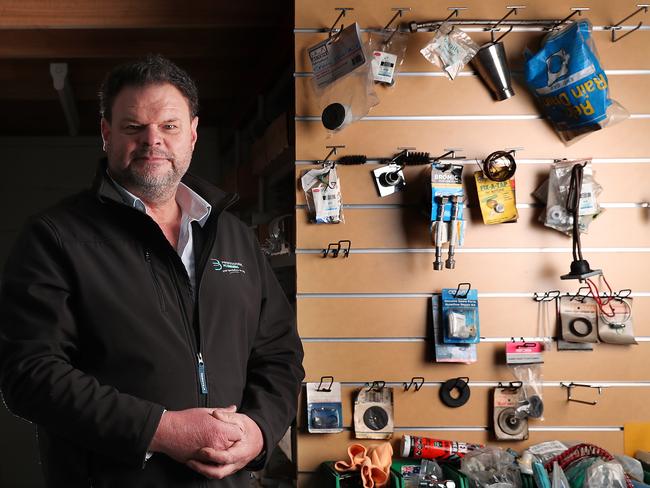Where Tasmanians have lost their jobs
Young Tassie workers are losing jobs twice as fast as middle-aged employees, fuelling fears they may never afford a home or have kids. They are also facing more competition. SEE THE LIST
Tasmania
Don't miss out on the headlines from Tasmania. Followed categories will be added to My News.
- Jobs 360 explained: Exposing Australia’s work crisis
- Hire and fire: Aussie workers losing 3500 jobs a day
Young Australians are getting sacked twice as fast as middle-aged workers, with the COVID-19 pandemic wiping out hundreds of thousands jobs in the past six months.
One in every 16 jobs held by workers in their 20s has vanished since March, as lockdowns and border closures smash the tourism, hospitality and retail sectors.
One in 40 middle-aged workers in their 40s and 50s has been sacked during the pandemic.
Baby Boomers have been harder-hit, with one in nine workers in their 70s and one in 16 workers in their 60s made redundant.
Centre for Future Work senior economist Alison Pennington yesterday warned a generation of young Australians could miss out on stable jobs, home ownership and having children.
“Full-time jobs are being replaced by smaller part-time jobs that are more likely to be insecure and casual,’’ she said.
“We will have a generation of Australians locked out of decent work, owning a home, making a family and building a sense of belonging in Australia.’’
The federal government is trying to cushion job losses for Millennials by spending $4 billion in a new JobMaker plan, to pay employers up to $200 a week to hire jobless people aged 16 to 35.
The government will also pay half the wages of 100,000 new apprentices and trainees.
Ms Pennington said older workers who lose full-time work now risk being unemployed for the rest of their lives.
“We’re looking at hundreds of thousands of older workers who’ll be piecing together an income through low-skilled part-time jobs, biding their time before they can get the pension at 66,’’ she said.
Across Tasmania, one in every 22 jobs has been wiped out during the pandemic.
Tasmania’s southeast coast lost one in six jobs, with one in 14 workers laid off in the Central Highlands.
In Hobart, one in 22 workers lost their job, compare to one in 20 workers in Launceston and one in 25 workers in Devonport.
Business owner Paul Bottomley feared jobs would be lost at his plumbing company when the COVID-19 pandemic broke out.
Servicing the Greater Hobart area, where one in 22 workers lost their job this year according to new tax office payroll data, Mr Bottomley appreciates the fortunate position his company has found itself in, being able to maintain all its staff.
“Right now, compared to the same time last year, our income is down about 20 per cent,” he said.
“I had fears of laying people off when the pandemic hit, but we’re probably luckier than most trades in that, as a plumber, we already use most PPE equipment, so we weren’t at much of a disadvantage.”

Mr Bottomley said he was pleased with government commitments announced in Tuesday night’s federal budget, which he said would assist his business.
Of interest to Mr Bottomley was the Boosting Apprenticeships Commencements Scheme, which will subsidise up to 50 per cent of an apprentice’s wages for businesses that hire apprentices between October 5 and September 30 next year.
“I had actually just taken on new apprentices, but I think the initiative is fantastic,” he said.
“I think the government has done a great job in unprecedented times. We’ve got to contend with the cards we’re dealt.”
New payroll data from the Australian Taxation Office, analysed by News Corp, reveals the hardest-hit suburbs and regions across the country.
The worst-hit industry is aviation, with 41 per cent of jobs wiped out during the pandemic.
One in five jobs was lost in the tourism, film, creative and performing arts industries, and 17 per cent of workers were sacked from the hospitality and restaurant sector.
But jobs rose 12 per cent in the gas supply sector, 5 per cent in electricity supply, and 8 per cent in the household services such as cleaning.
Soaring demand for cleaning products and hand sanitiser boosted jobs by 7 per cent in the chemical product manufacturing sector.
Hospital employment rose 3 per cent, and public service jobs rose 4 per cent.
The tax data, published by the Australian Bureau of Statistics, is based on employers with a Single Touch real-time payroll system.

On Monday October 12 at 8pm AEDT, News Corp will air its Jobs 360 panel discussion online here.
On Tuesday we will highlight some of the solutions our experts are advocating to head off the crisis and point to almost 100,000 jobs region by region to help those looking for a job get back to work.
– with James Kitto
Originally published as Where Tasmanians have lost their jobs

